|
GO TO:
CROSSOVER
CROSSOVER LAYOUT
CABINET CROSSOVER
KIT
MEASUREMENTS
6620 VERSION
Ellam FLEX is just what the
name suggests, flexible. The idea is to make a small two-way from the
venerable 15W/8530K00 - still the best 5" I know of - as an
upgrade/replacement to former Ellam 9800, Ellam XT and W1500/97
constructions. These constructions will disappear from my website as I
think I can do better today with all experiences gained over the last
eight years, not least the
Jenzen
speakers.
Finally this construction will be extended
with an 8" Revelator bass driver, most likely
22W/4851T00, to make a
3-way system, either run from a new passive 3-way crossover - or run
from an electronic crossover with the current 2-way crossover in
place. The price for the latter is a final system sensitivity of ~84
dB, where a new 3-way crossover can produce a system sensitivity
around 88 dB by using the 4 ohms bass driver.
If an electronic
solution is preferred, the 8 ohms bass driver version,
22W/8851T00, can obviously
be used. Thus the number of possible 3-way systems can be sixteen
depending on tweeter choice, bass driver impedance and passive vs.
electronic solutions (4 x 2 x 2).
The 3-way passive will also
replace the Jazzman construction as there is no rationale for the
inefficient Revelator alu driver,
22W/8857T00, although this
driver
obviously can be used with the Ellam-Flex 2-way - and an electronic
crossover. No objection.
As can be seen there are no tweeters
from the SS Classic range. I think these tweeters have a hard time
being stuck between some really good domes from the Discovery series
and the higher priced Revelator/Illuminator ranges.
Ellam FLEX takes advantage of
the Jenzen front panel designs and features a stepped baffle allowing
proper time alignment of drivers and implementation of true
LR2 filters. The 3-way version will be
Ellam
Flex 3W.
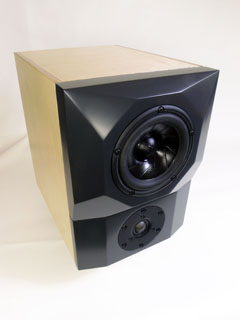
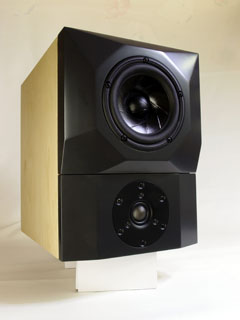
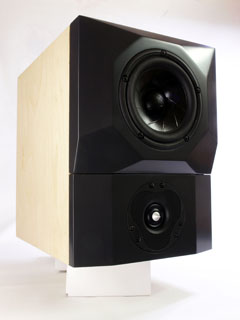
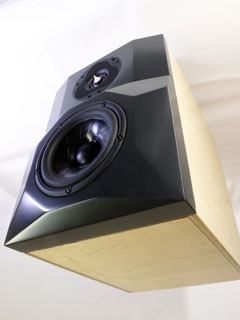
Click images to view large.
Obviously you can turn the speaker
upside down to your liking.
The Sound
I could hardly wait after
finishing the first crossovers to take the Ellam FLEX to our living
room and connect to my
GlowMaster KT 88 valve amp. After some tweaking
of tonal balance by changing the value of L2011 - and actually
completely remodel the tweeter section - time was in for some serious
listening. Thus, a wide range of recordings, vinyl and 24 bit were
played and I can understand why some people settle with a
pair of the 15W Revelator minis. Even in our 25 sqm living room they
do deliver a credible soundstage and I'm impressed how the handle a
grand piano with proper weight and tonal balance. The 65 watts from
the GlowMaster have no trouble swinging the Ellam Flax to their limit.
Tweeter attenuation again was tried out and I finally ended up
with R1011 being 2.2 ohm.
Some serious choral works were
played and proved mid-treble integration on par with the best of my
Jenzen speakers and DTQWT. What they obviously do not is handling the
dynamics of larger speakers - but we can't have it all from ~10 litres
and a 95 cm^2 cone. I went through all the recordings listed here from
the
GlowMaster review.
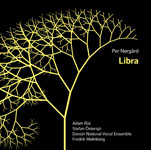
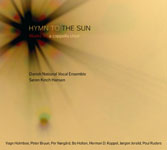

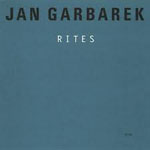
From left: Per Nørgård:
Libra and Hymn to The Sun,
Works for a chapella choir.
William Carter:
Fernando Sor Late Works.
Jan Garbarek:
Rites.
The Ellam FLEX did all
of these demanding recordings without ever giving up on resolution or
sounding harsh. This indeed promises very well for the 3-way version.
Numerous other recordings were on the spinner, from Eva Cassidy and
Johnny Cash to Miles Davis and Keith Jarrett. Even Safri Duo,
Samb-Adagio, they handle with punch and drama. The 15W Revelator
- despite a predicted F3 of 55 Hz - has the ability to at least make
us believe it goes much deeper. I guess it's because what it does, it
does really well. Remarkable driver.
The Drivers
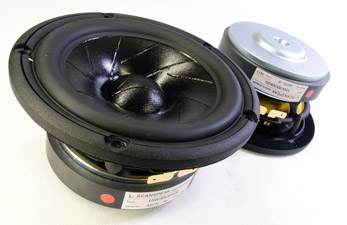
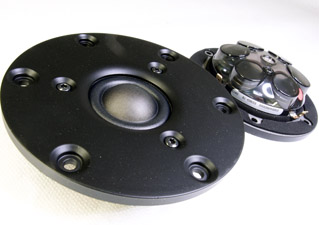
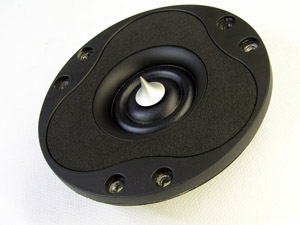
15W/8530-K00, D3004/660000
and R3004/662000 drivers. Click images to view large.
Download specs here:
15W/8530-K00
D3004/660000
R3004/662000.
CROSSOVER
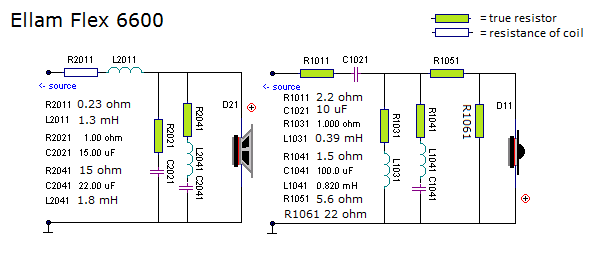
*:
Most
5" drivers will have a rising response towards higher frequences.
When we place these on a narrow baffle we have baffle step loss; for
e.g. 20 cm width we will be 3 dB down around 580 Hz. These two things
combined often leaves a serious bump around 800-1200 Hz and we need to
flatten the response here, otherwise the sound will become much too
forward. What is seen over and over again is the use of a large series
coil for the bass driver bringing down the upper midrange and the
result is a dip in the middle midrange (320-640 Hz) which often makes
male vocals thin and anemic; we miss some weight in the overall
soundstage as there is a significant amount of energy in almost any
music in this range. Thus, a low-value series coil and a linearising
circuit can solve the problem. For diy people this doesn't impact cost
considerably, but for a commercial designer it's three extra
components and they mostly take the easy way.

Crossover simulation targeting a point of crossover in the region of 2
kHz, 2nd order LR topology. Seems manageable.
CABINET
back to index
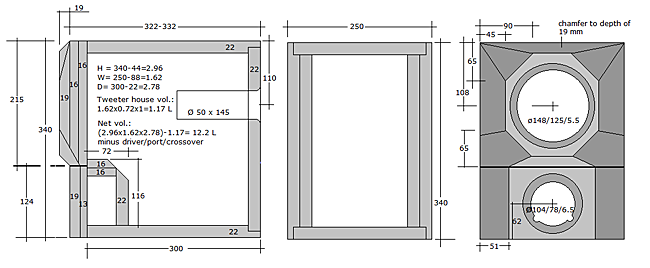
Click image to view large.
GO TO ELLAM FLEX CABINET PAGE FOR DETAILS
ON CONSTRUCTION
MEASUREMENTS
back to index
Measurements may
give us an idea of tonal balance of a system, i.e. too much or
too little energy in certain areas. Measurements may tell us
about bass extension if far-field measurements are merged with
near-field measurements. In addition to this ports may contribute
to bass extension. Most of us diy'ers do not have access to an
anechoic room for full-range measurements from 20-20000 Hz.
What cannot be seen is what kind of bass performance we get in a
given room. Bass performance is highly dependent on in-room
placement of your speaker and the same speaker can be boomy in
one place and lean in another.
Actual SPL level at 1 meter
distance and 2.8V input is useful for en estimate of system
sensitivity and combined with the impedance profile may give an
idea of how powerful an amplifier is needed to drive the speaker
to adequate levels.
What measurements do not tell is the very sound of the speaker
unless displaying serious linear distortion. The level of
transparency, the ability to resolve micro-details, the
"speed" of the bass, etc., cannot be derived from these
data. Distortion measurements rarely tell anything unless
seriously bad and most modern drivers display low distortion
within their specified operating range.
Many people put way too much into these graphs and my comments
here are only meant as warning against over-interpretation. There are
way more to good sound than what can be extracted from a few graphs.
Every graph needs interpretation in terms of what it means sonically
and how it impacts our choice of mating drivers, cabinet and crossover
design.
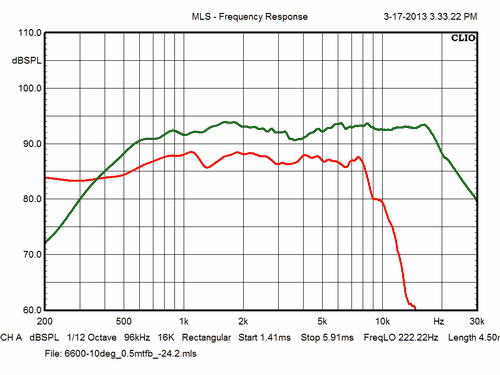
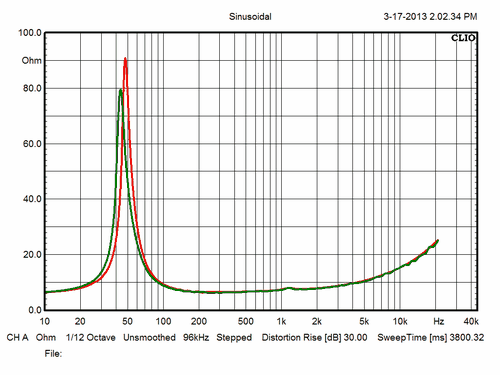
Left: 6600 and 15W response @ 0.5 meter,
10 deg off axis, normalised for 1 metre 2.8 volts. As we rarely
listen strictly on-axis this may display a better starting point for
crossover simulation. The dip at 1.3 kHz is due to all too common
rubber surround resonance. Not much we can do about it.
Right: ScanSpeak claims Fs = 30 Hz and I have hard
time accepting this. Out of the box I measure 47 Hz and after
2 hours 40 Hz massage at +/- 5 mm excursion, I measure 43 Hz.
I checked my old files and found 38 Hz from 4 drivers after
burn-in, so I think we can assume some 40 Hz +/- 2 Hz. 30 Hz
for a small 5" driver does seem exceptionally low considering
the light-weight paper cone and that suspensions aren't that
loose. I find other measurements on the
web suggesting something in the range of 40-45 Hz. Not sure if
these drivers were broken in. However, this will rise the
driver Qt to something in the range of 0.35-0.40 and makes an
F3 = 55 Hz in an 11 litre cabinet.
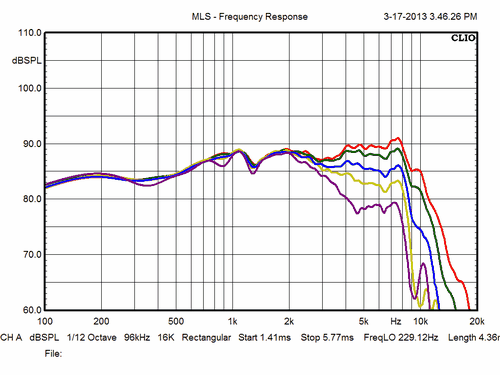
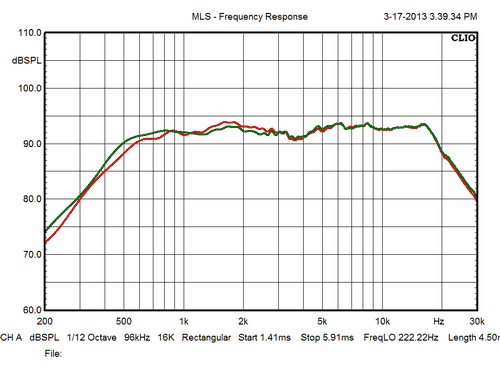
Left: Dispersion of 15W driver in
cabinet at 0, 10, 20, 30 and 40 deg. horizontally.
This driver
really does well up to 3 kHz and with a point of crossover around 2.2
kHz we're more than safe in providing an even power response.
Right:
Response of 6600 tweeter in cabinet at 10 deg. off axis
with (red)/without(green) added bass panel.
The follow-up to this
project, a 3-way, looks promising.
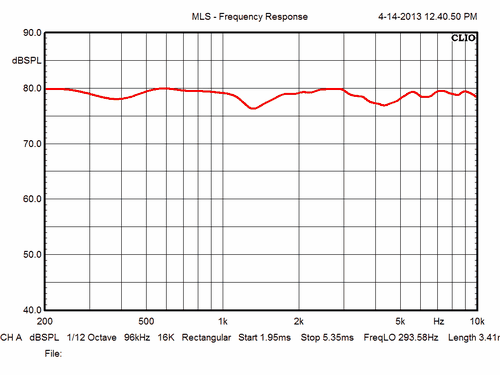
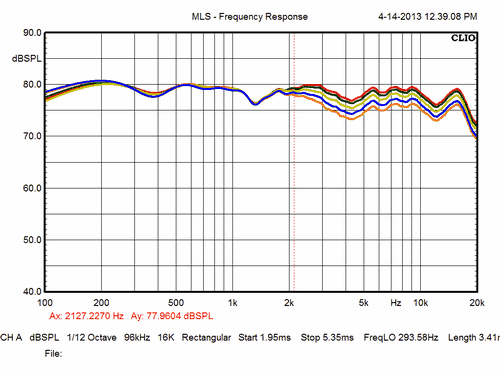
Left: Final system response in the critical
range of 200-10000 Hz. R1011 = 1.0 ohm providing an almost flat
response. What we see is a frequency response around 84 dB +/- 1.5 dB.
I would rate this speaker having an on-axis response of 84 dB at 1
meter distance for 2.8V input signal.
R1011 = 1 ohm is a
bit too bright to my taste and 2R2 is more like it,
making a
balanced upper treble with still a lot of detail due to the 1-4 kHz
range almost unchanged.
Right: R1011 = 1.0, 1.5, 2.2, 3.3 and 4.7
ohm. I don't think you'll need 1R0 or 4R7 to find what will suit you
best.
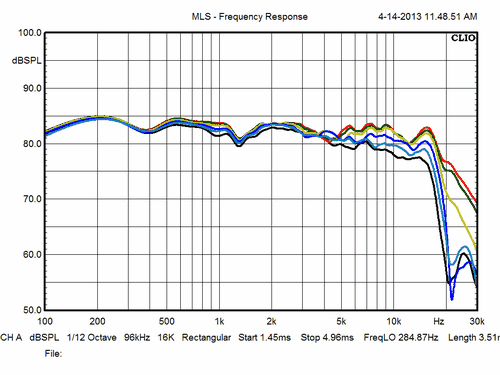
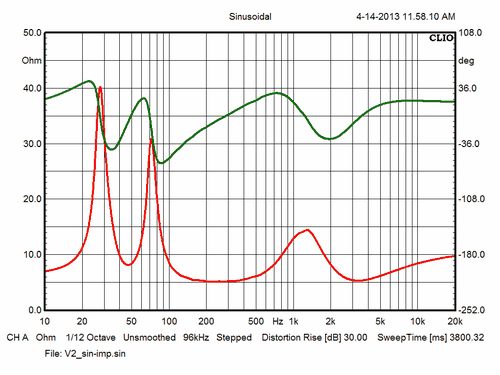
Horizontal dispersion at 0, 10, 20,
30, 40 and 50 deg angle. Note the 1-5 kHz range is hardly impacted
from this.
Right: Final system impedance, min. 5 ohms at 200-400
Hz. My new
GlowMaster KT88 valve amp has no
trouble driving this speaker at all.
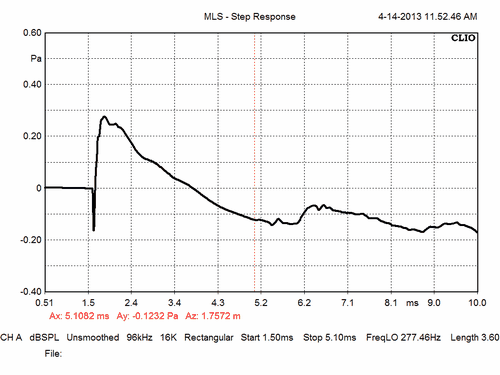
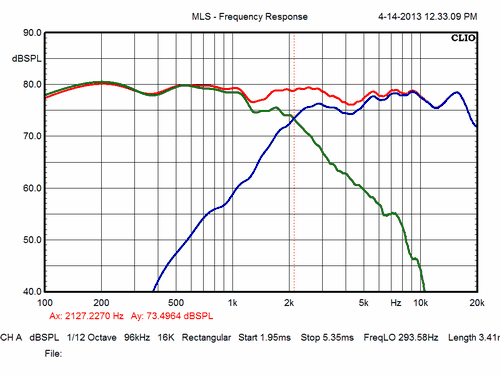
Left: Step response for those interested. Tweeter
reponse well integrated in midbass response.
Right: Drivers' response
and summed response driven from crossover. Point of crossover ~2.1 kHz.
CROSSOVER
KIT
back to index
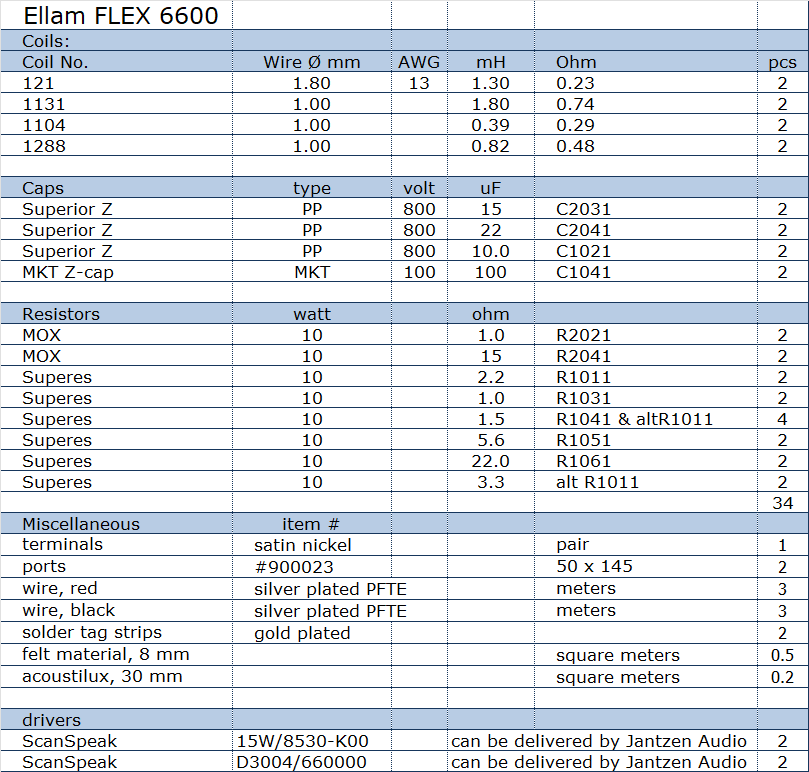
All technical questions
at:
troels.gravesen@hotmail.com
CROSSOVER
LAYOUT
back to index
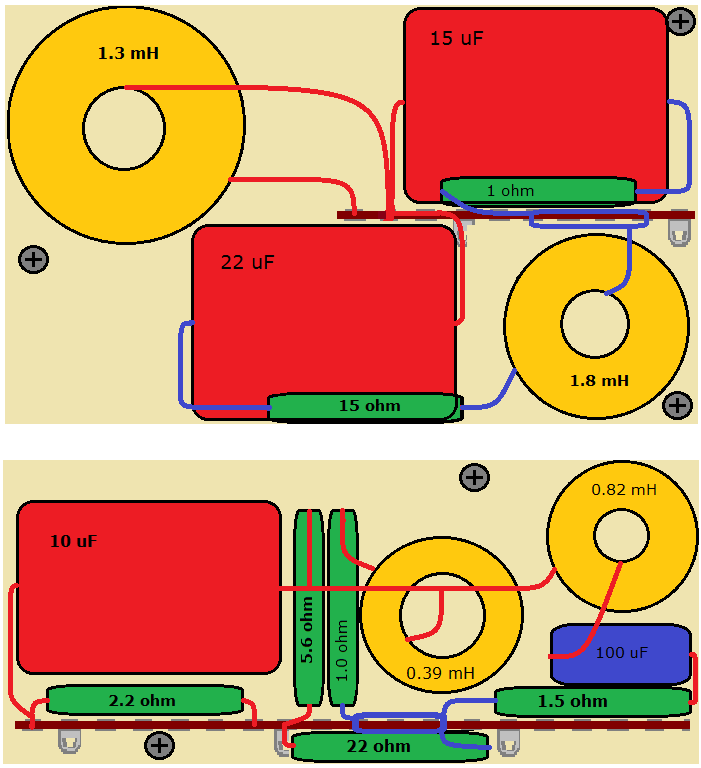
Tweeter and bass sections
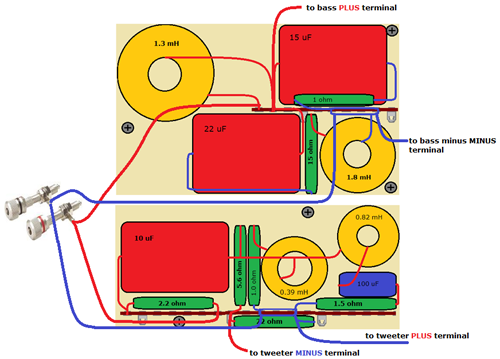
Ellam-FLEX-6600 wiring, click image to view
large.
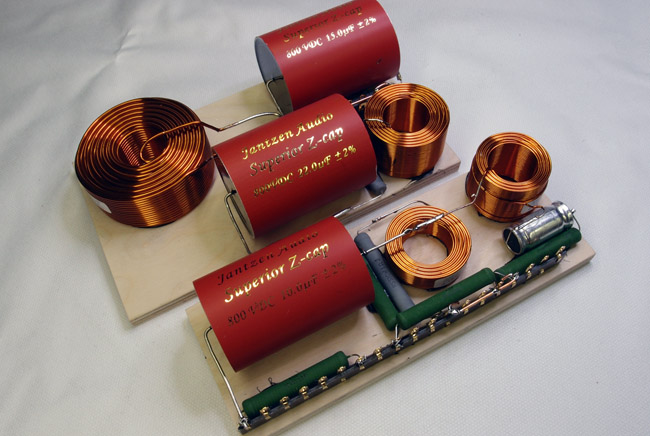
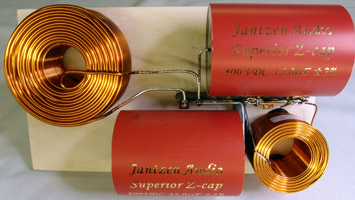
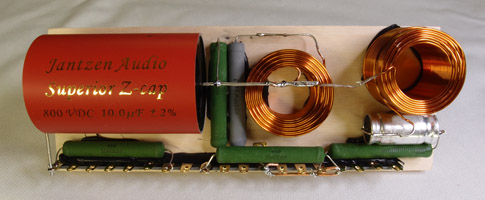
Click images to view large.

Click image to view large. Download specs
here.
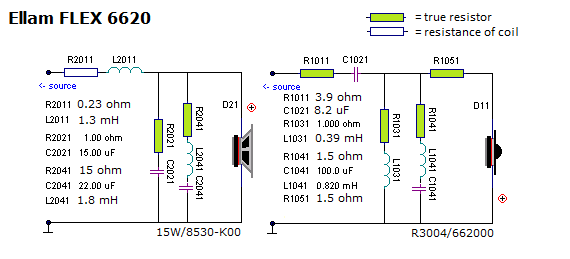
Ellam FLEX R3004/662000 version crossover.
Compared to D3004/660000 tweeter, C1021 has been changed to 8.2 uF.
The rest is only changes to attenuation resistors.
Ellam FLEX 6620 Crossover Kit
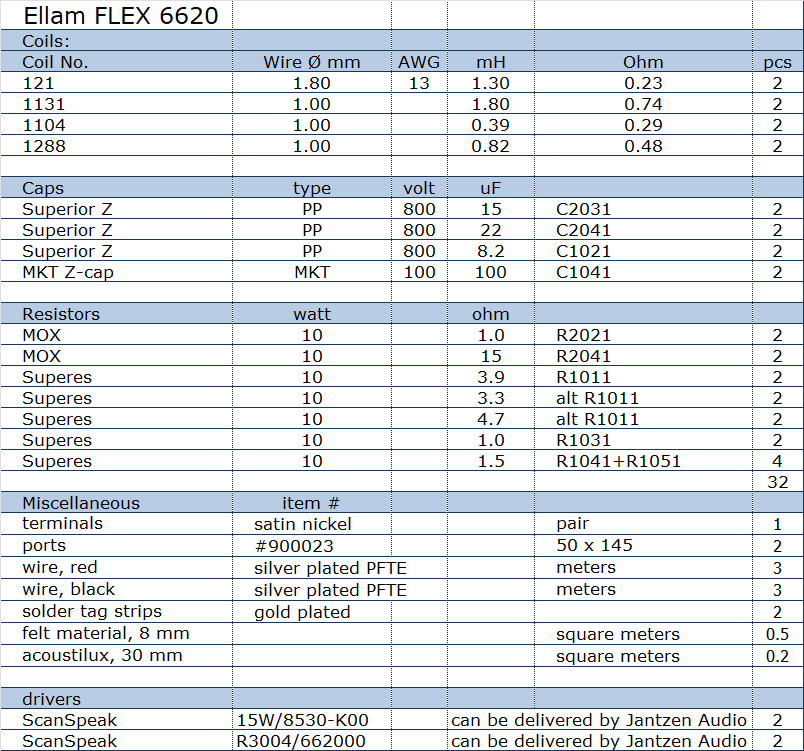
All technical questions
at:
troels.gravesen@hotmail.com
Ellam FLEX 6620 measurements
back to index
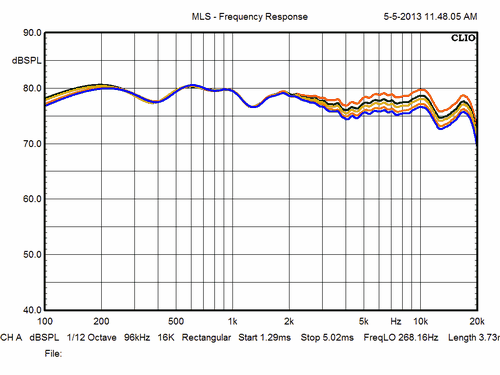
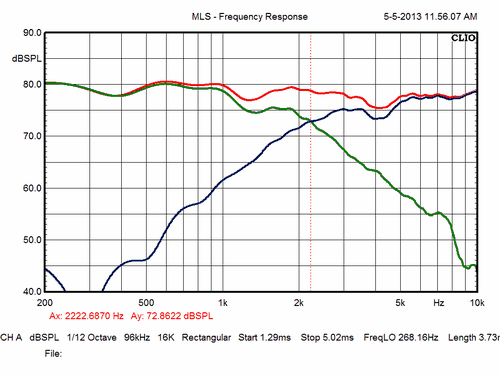
Left: SPL from 6620 version from
R1011= 1R5, 2R2, 2R7, 3R3 and 3R9. Right: Point of crossover = 2200
Hz.
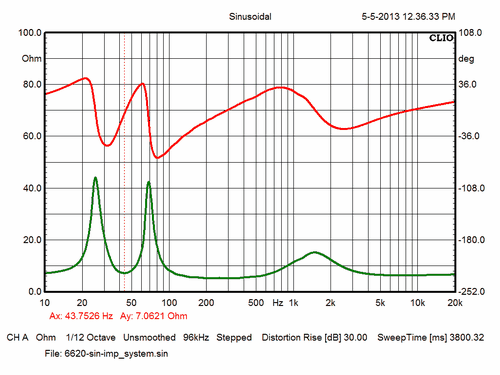
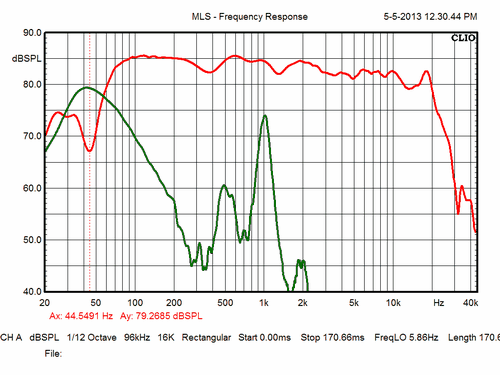
Left: Impedance from 6620 version. Right:
Far field measurement merged at 200 Hz with midbass near field
measurement. Port contribution shown and this demonstrates why having
a rear port is sometimes better (peak at 1 kHz). Ports often leak
midrange - and not the good part.
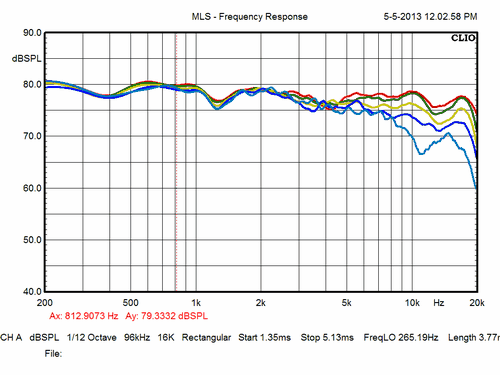
Horizontal dispersion shown at 0, 10, 20, 30 and 40 deg. Compare
to 6600 dome above.
This is one reason ring radiators sound
different from conventional domes.components needed.
|




































